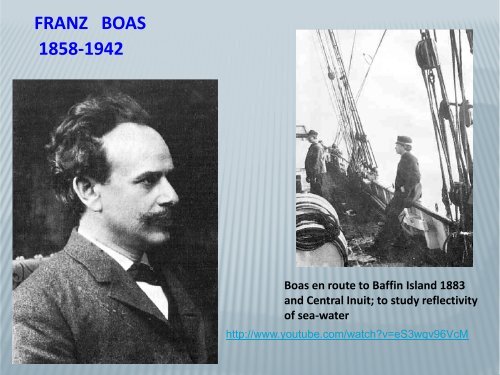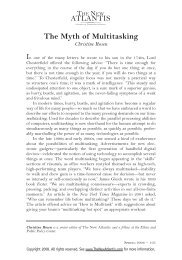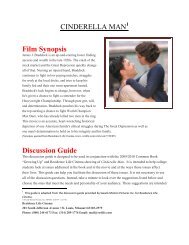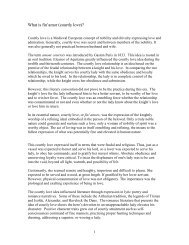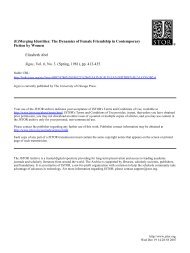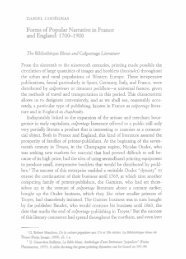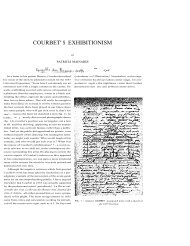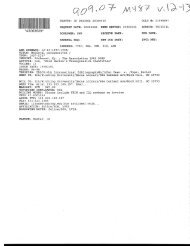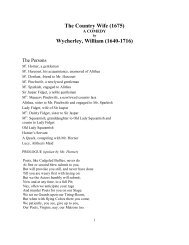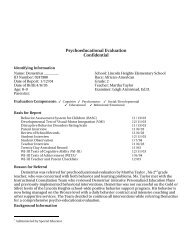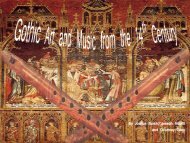FRANZ BOAS 1858-1942
FRANZ BOAS 1858-1942
FRANZ BOAS 1858-1942
Create successful ePaper yourself
Turn your PDF publications into a flip-book with our unique Google optimized e-Paper software.
<strong>FRANZ</strong> <strong>BOAS</strong><br />
<strong>1858</strong>‐<strong>1942</strong><br />
Boas en route to Baffin Island 1883<br />
and Central Inuit; to study reflectivity<br />
of sea‐water<br />
http://www.youtube.com/watch?v=eS3wqv96VcM
http://www.youtube.com/watch?v=p5NSKRc0<br />
7Fo&feature=related<br />
Dances<br />
http://www.youtube.com/watch?v=eS3wqv96<br />
VcM<br />
Odyssey Series on Boas
PERSONAL INFORMATION<br />
Born on July 9, <strong>1858</strong> in<br />
Minden, Westphalia, Germany<br />
Parents: Meier Boas & Sophie<br />
Meyer Boas<br />
Married to Marie Krackowizer
PERSONAL INFORMATION<br />
Studied geography & physics at<br />
Universities of Heidelberg, Bonn,<br />
and Kiel<br />
Earned Bachelors University of<br />
Heidelberg in 1881<br />
Same year, earned Ph.D. from<br />
University of Kiel
PERSONAL INFORMATION<br />
Expedition to Baffin Land, Canada<br />
in 1883-1884<br />
Fieldwork among the Eskimo<br />
Became interested in<br />
anthropology<br />
Immigrated to United States in<br />
1885
PERSONAL INFORMATION<br />
Worked for journal Science<br />
Editorial position<br />
Fieldwork along North Pacific<br />
Coast of North America for<br />
several museums 1885-1896
PERSONAL INFORMATION<br />
Project for World's Fair in Chicago<br />
1892-1893<br />
Brought Native American cultures<br />
to general public at the fair<br />
Pioneered concept of life group<br />
displays<br />
Dioramas
CHICAGO WORLD’S FAIR DIORAMA
<strong>BOAS</strong>’ CAREER<br />
Moved to New York in 1896<br />
Became Assistant Curator of<br />
Ethnology & Somatology<br />
American Museum of Natural<br />
History<br />
Lectured at Columbia University<br />
Professor of Anthropology,1899
<strong>BOAS</strong>’ WORK<br />
Best known for work with<br />
Kwakiutl Indians from Northern<br />
Vancouver & adjacent mainland of<br />
British Columbia, Canada<br />
Established new concept of<br />
culture & race
<strong>BOAS</strong>’ WORK<br />
Everything was important to the<br />
study of culture<br />
Collecting data on all facets of a<br />
culture was necessary to<br />
understand that culture
KWAKIUTL INDIANS
KWAKIUTL INDIANS<br />
Bear Totem Pole Wearing a Mask
CENTRAL ESKIMO (IGULIK) STUDY<br />
Inuit can perceive and name<br />
hundreds of colors and<br />
qualities of sea‐water and<br />
surfaces unknown in<br />
European languages…<br />
Boas’ study: Earliest<br />
anthropological attempt to<br />
describe a non‐European<br />
‘ethno‐science’ in<br />
phenomenological terms
Analyst seeks to understand phenomena by grasping<br />
how they make sense within the framework of the<br />
subject’s thought‐world<br />
Hamats'a coming out of secret room," and "Kwakiutl Indian ceremony for<br />
expelling cannibals."
1885: First expedition to<br />
Northwest Coast (Bella<br />
Coola)<br />
1886: First collecting trip<br />
for American Museum of<br />
Natural History (New<br />
York City) to Nootka and<br />
Kwakiutl — massive<br />
documentation of<br />
Northwest Coast culture
THE PRACTICE OF MUSEUM<br />
EXHIBITS<br />
Boas at American Museum, 1900<br />
No storage rooms, natural lighting, cases, life groups the<br />
most demanding (time, materials, skill), attempted realism.<br />
Labels – “the ultimate limitation to the possibility of a<br />
museum anthropology”.<br />
Boas believed the exhibited artifact secondary to the<br />
monographic interpretation of a scientist
4/12 TYPOLOGICAL VS. LIFE GROUP<br />
U.S. National Museum<br />
Typological, 1890<br />
U.S. National<br />
Museum<br />
Life group, 1896
MUSEUMS: ENTERTAINMENT,<br />
INSTRUCTION, RESEARCH<br />
Boas curator at the American<br />
Museum 1896-1905<br />
Over 90% of visitors “do not want<br />
anything beyond entertainment”<br />
Visitor groups - children, school<br />
teachers, researchers<br />
Researchers justify large museums<br />
“for the advancement of science”
CULTURAL RELATIVISM<br />
Differences in peoples the result<br />
of:<br />
Historical<br />
Social<br />
Geographic conditions<br />
All populations had complete and<br />
equally developed culture
CULTURAL RELATIVISM<br />
Countered early evolutionist view of<br />
Louis Henry Morgan & Edward Tylor<br />
Developed stages that each culture<br />
went through during development<br />
The views of Franz Boas and those of<br />
his students changed American<br />
anthropology forever
HISTORICAL PARTICULARISM<br />
Each culture has a unique history<br />
Should not assume universal laws<br />
govern how cultures operate
ASSUMPTIONS OF HISTORICAL<br />
PARTICULARISM:<br />
1. Rejects general laws, ranking on<br />
a scale, concept of “progress”<br />
2. No simple or complex societies,<br />
only different societies<br />
3. The idea of “Unilineal evolution”<br />
Based on speculation<br />
4. Is ethnocentric 23
ASSUMPTIONS OF HISTORICAL<br />
PARTICULARISM:<br />
6. Not Culture, but cultures<br />
7. Culture, not race, determines<br />
behavior<br />
8. Methodological rigor
<strong>BOAS</strong>IAN CONCEPT OF CULTURE<br />
• Superorganic —The product of<br />
collective or group life; but the<br />
individual has an influence<br />
• Unconscious —A filter through which<br />
reality is perceived, but which is not<br />
itself the object of attention<br />
• Adaptive —Culture ultimately helps<br />
individuals adapt to their environment.
IMAGES OF NATIVE AMERICANS<br />
//thesocietypages.org/socimages
SOCIAL<br />
AND<br />
CULTURAL<br />
PHYSICAL<br />
ANTHROPOLOGY<br />
Four Field Approach<br />
ANTHROPOLOGY<br />
ARCHAEOLOGY<br />
LINGUISTICS
Generation of anthropologists trained under Boas at<br />
Columbia University and established Boasian<br />
doctrines in North American universities:<br />
Alfred A. Kroeber<br />
Ruth Benedict<br />
Margaret Mead<br />
Rhoda Métraux<br />
Robert Lowie<br />
Edward Sapir<br />
Paul Radin<br />
Alexander A. Goldenweiser<br />
Clark Wissler
Cultural Relativism<br />
Historical Particularism<br />
“Race, language, and culture” as<br />
independent variables<br />
Superorganic<br />
Cultural Determinism<br />
Data Collection “without” theory<br />
Emphasis on Fieldwork<br />
4-field approach<br />
<strong>FRANZ</strong> <strong>BOAS</strong>
CONTRIBUTIONS TO ANTHROPOLOGY<br />
1937--Professor Emeritus of<br />
anthropology at Columbia<br />
University<br />
Made anthropology into a<br />
distinguished and recognized<br />
science
CONTRIBUTIONS TO ANTHROPOLOGY<br />
Author of many books, some of which<br />
are:<br />
Growth of Children (1896 – 1904)<br />
The Mind of Primitive Man, 1938<br />
Primitive Art, 1927<br />
Anthropology and Modern Life, 1938<br />
Race, Language, and Culture, 1940<br />
Dakota Grammar, 1941
CONTRIBUTIONS TO ANTHROPOLOGY<br />
Boas, professor emeritus of anthropology<br />
at Columbia University, was entertaining<br />
Professor Paul Rivet and other colleagues<br />
at a luncheon in the Faculty Club.<br />
He collapsed into the arms of another wellknown<br />
anthropologist, Claude Levi-<br />
Strauss, and died on December 21, <strong>1942</strong>.


